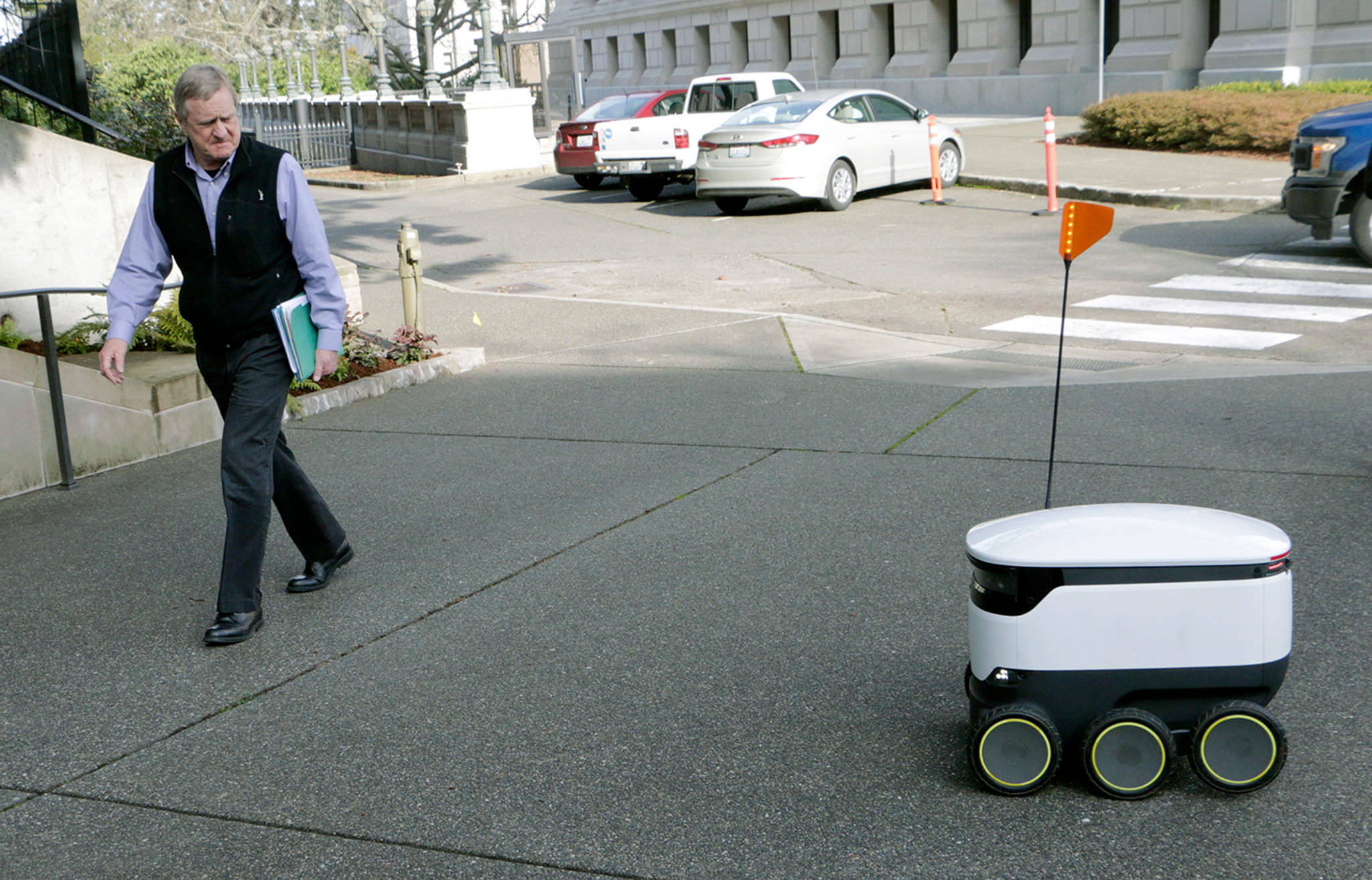OLYMPIA — Monday marked the launch of a conversation on what should be the rules of the road, so to speak, for those wishing to use electric-powered, remote-controlled devices — a.k.a. robots — to deliver products to customers’ front doors.
“Our company is very conscious of the need for a regulatory framework,” said David Catania, a spokesman for Starship Technologies, as one of the company’s six-wheeled autonomous machines tooled around a corner of the Capitol campus at lunch time for lawmakers to eyeball.
Catania, managing director of Georgetown Public Affairs, later testified to transportation committees in the House and Senate on bills to put legal sideboards in place before robots are routinely seen cruising along sidewalks and in crosswalks around the state.
The bills, with identical language, are sponsored by Sen. Marko Liias, D-Lynnwood, and Rep. Shelley Kloba, D-Kirkland.
“I want you all to embrace the future that is right now in front of us,” Kloba told her House Transportation Committee colleagues.
The future has been on display this past week in Snohomish County.
Amazon deployed a half-dozen cobalt-blue “Amazon Scouts” Jan. 23 to deliver packages in undisclosed areas of the county. During the first forays, the six-wheelers were to be accompanied by an Amazon employee, according to the company.
The personal delivery vehicles, which resemble mini-fridges on wheels are designed to navigate around “pets, pedestrians and anything else in their path.”
What Starship Technologies brought to the Capitol on Monday is visually similar. It’s got six wheels with its front ones able to go up, like a wheelie, to scale a curb. It can travel 4 miles an hour.
It’s about 60 pounds when empty, with a carrying capacity of about two bags of groceries.
Employees monitor up to seven devices at a time in places where the company currently operates, Catania told lawmakers. While the machines are in autonomous mode more than 90 percent of the time, an employee can manually intervene should one encounter an obstacle or other problem, he said.
Washington has no law covering this new technological breed.
Thus, Catania testified, the self-propelled devices could potentially fall under the state’s definition of “motor vehicle” and be prohibited from traveling on sidewalks. With Senate Bill 5378 and House Bill 1325, the potential prohibition is removed.
The resulting regulations would be similar in design to what exists in seven states and the District of Columbia where the company has deployed these autonomous vehicles.
Under the bills, a “personal delivery device” is defined as any electric-powered machine weighing less than 120 pounds empty that is equipped with automated driving technology. This technology would allow for its operation remotely.
They will be allowed travel on sidewalks and in crosswalks, at no more than 10 miles per hour though Kloba said the maximum speed may be adjusted.
They must be equipped with a braking system and, if used at night, must have front and rear lights which make it visible up to 500 feet away to passing vehicles. Owners must maintain an insurance policy with a minimum of $100,000 in general liability coverage.
Transporting of hazardous materials is prohibited. And Kloba said she’s open to prohibitions on specific cargo, like alcohol.
Those operating one of these robots must follow the same rules as apply to pedestrians. Any violation is a traffic infraction with the citation issued to the owner.
As written, cities could enact tougher rules and set quotas.
There are wrinkles to iron out.
The state Department of Transportation wants the bills amended to add a requirement for some sort of flag to make them visible from farther away. Officials also want them to provide an audio warning when approaching pedestrians and bikers.
Jerry Cornfield: 360-352-8623; jcornfield@herald net.com. Twitter: @dospueblos.
Talk to us
> Give us your news tips.
> Send us a letter to the editor.
> More Herald contact information.

























